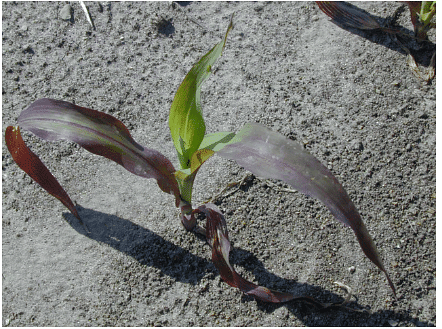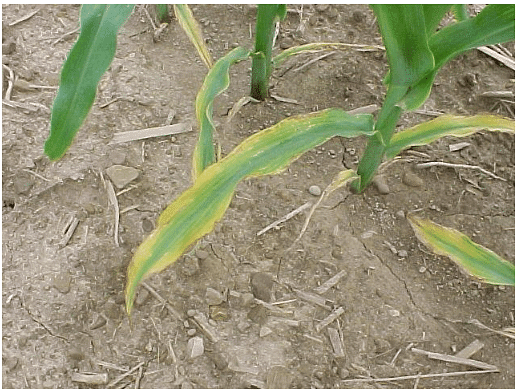Importance of Phosphorus and Potassium for Plant Growth | Agriculture Optional for UPSC PDF Download
Introduction
Phosphorus (P) and potassium (K) are among the twelve essential nutrients necessary for the growth of plants. Both P and K are absorbed in significant amounts by corn plants. Phosphorus plays a vital role in encouraging the development of roots and shoots and fostering robust seedling growth. Potassium is crucial for the growth of corn because it enhances disease resistance and the plant's ability to withstand water stress. Having an adequate supply of K improves the corn plants' efficiency in absorbing other essential nutrients. Decisions related to fertility management are guided by soil test results and calculations of how much P and K the crop removes from the soil.
Phosphorus Availability
- Phosphorus in the soil is considered an "immobile nutrient," which means it doesn't move far within the soil over time. The effectiveness of phosphorus uptake is influenced by factors like soil moisture and temperature. Drier soil conditions can hinder the root system's ability to take up phosphorus. Phosphorus exists in both organic and inorganic forms in the soil. However, a significant portion of phosphorus in the soil is chemically bound in a way that is not readily available to crops in a single growing season. The amount of phosphorus accessible for plant uptake is relatively low compared to the total phosphorus content in the soil. For instance, while the total soil phosphorus might exceed 800 to 1,000 pounds per acre, the phosphorus available to plants in the soil solution could be as low as 0.04 to 0.13 pounds per acre.
- As a crop extracts available phosphorus, the soil gradually releases more plant-accessible phosphorus into the soil solution. If the plant's phosphorus demand surpasses what the soil can provide, the plant may experience a deficiency. Soil tests don't measure the total phosphorus content in the soil but are designed to predict if the soil can release sufficient available phosphorus during the growing season to support the projected yield. Fertilizer recommendations are determined based on soil test results indicating the potential for a yield response.
- Manure serves as a valuable source of phosphorus, primarily in organic form. The amount of phosphorus available to plants in manure can fluctuate due to various factors, including the animal's diet, animal species, manure handling and storage practices, and the type and quantity of bedding material used. Manure provides a source of slow-release phosphorus that needs to be broken down by soil microbes into forms that plants can use.
Role of Phosphorus in Plant Development
- Plants have a continuous need for phosphorus (P) to support their growth across their entire life cycle, with a particular emphasis on the initial stages of growth and development. Phosphorus plays a crucial role in the conversion of solar energy into the chemical energy that plants require to create sugars, starches, and proteins. It is indispensable for the effective transfer of energy, generated through photosynthesis, to be utilized for plant growth and reproduction.
- Maintaining sufficient levels of phosphorus during the early stages of growth is essential to promote the development of both shoots and roots, which is vital for establishing a healthy crop. Adequate phosphorus also enhances water use efficiency and the potential for higher yields. When phosphorus levels are insufficient, corn plants are unable to grow, produce, or withstand various environmental stresses.
Cold Temperature Induced Phosphorus Deficiency Symptoms
- Early-season phosphorus (P) deficiency symptoms can manifest in cold soils even when there is adequate phosphorus content in the soil. In cold soil conditions, root growth and nutrient uptake are restricted, leading to a temporary shortage of phosphorus. This can result in plants that appear stunted or have a purple hue, as shown in Figure 1. At times, the purple coloring is not necessarily an indication of a phosphorus deficiency but may be linked to air temperature and sunny days. The purple coloration is caused by the accumulation of reddish-purple pigments.
- One theory suggests that the combination of bright, sunny days and cool nights (with temperatures in the 40s to 50s Fahrenheit) during the V3 to V6 growth stages leads to the buildup of these pigments due to high daytime photosynthetic activity and limited metabolic activity at night. This condition does not have a negative impact on crop yield, unlike when the symptoms result from a genuine phosphorus deficiency. These symptoms tend to subside as the soil warms up.
- In some instances, certain corn varieties may exhibit purple seedlings during early development due to their genetic traits, which can be mistaken for cold-induced phosphorus deficiency. This purple coloring can be observed in some corn varieties at various stages of plant growth.
 Figure 1: Phosphorus deficiency symptom in corn, older leaves turn purple in color.
Figure 1: Phosphorus deficiency symptom in corn, older leaves turn purple in color.
Phosphorus Uptake During Critical Growth Stages
- Corn plants experience a significant boost in phosphorus (P) uptake after they reach the V6 growth stage, which typically occurs about four to six weeks after planting. This increased P uptake continues until the plant approaches maturity. During the mid- to late-season, phosphorus uptake is primarily directed towards the reproductive phase.
- In older corn plants, symptoms of phosphorus deficiency become apparent and may include stunted growth, yellowing along the edges of older leaves, thinner and shorter stalks, and potential delays in reaching maturity. The deficiency can be confirmed through soil testing or by assessing P levels in plant tissues.
Potassium
Important Potassium Soil Characteristics
- Similar to phosphorus (P), a significant portion of the potassium (K) in the soil is not readily accessible for the growth and development of plants. The overall quantity of K in the soil typically ranges from 5 to 25 tons per acre. The vast majority of K is bound within the soil as a structural mineral component.
- The availability of K provided by the soil can vary throughout the growing season, influencing whether a potassium deficiency becomes evident in a corn crop. Fields with compacted soil or those implementing conservation tillage practices without the application of a subsurface band of K may exhibit potassium deficiency. Additionally, dry soil conditions can have an adverse impact on the uptake of soil K by plant roots. Light or sandy soils, in particular, tend to have lower K soil test levels, which may necessitate higher K fertilizer applications.
Role of Potassium in Plant Development
- Potassium plays a crucial role in facilitating the movement of water, nutrients, and carbohydrates within the plant. These functions support early growth, enhance the production of proteins, and improve the plant's efficiency in utilizing water while also bolstering its resistance to diseases and insects. When plants lack sufficient potassium, they encounter challenges in absorbing both water and nitrogen from the soil, which can exacerbate drought stress.
- Corn plants employ a mechanism to conserve water and reduce moisture stress by regulating the closure of leaf stomata, which are small openings found on the undersides of leaves, and this process is influenced by potassium. Plants with insufficient potassium may exhibit slower stomata closure, diminishing their protection against drought stress. Furthermore, these deficient plants may experience a decrease in their ability to produce energy through photosynthesis.\
Role of Potassium in Stalk Rot Disease
- Stalk rots represent one of the most prevalent and detrimental diseases affecting corn crops. These diseases can lead to reduced yields due to premature plant death and lodging. The extent of damage caused by stalk rot can be minimized by maintaining an optimal balance between potassium (K) and nitrogen (N) levels in plant tissue.
- An excessive amount of nitrogen, when not balanced with potassium, can trigger rapid growth, which might result in the plant having insufficient structural integrity to defend against fungal pathogens responsible for stalk rot.
- Potassium has been linked to enhancing the strength of corn stalks. When corn plants absorb an adequate amount of potassium, the drying process of the stalks after maturity is better regulated, reducing the risk of lodging.
Potassium Uptake During Critical Growth Stages
 Figure 2: Potassium deficiency symptoms in corn on outer leaf margins, appearing on older leaves first.
Figure 2: Potassium deficiency symptoms in corn on outer leaf margins, appearing on older leaves first.
- Corn plants experience a significant increase in potassium (K) uptake at the V6 growth stage, which typically occurs around four to six weeks after planting. The uptake of potassium is generally completed shortly after the silking stage (R1). When there is a high demand for K, but an insufficient supply, symptoms of potassium deficiency may become noticeable.
- The initial signs of potassium deficiency in corn manifest on the lower leaves because potassium is easily transported within the plant from older leaves to younger ones. These leaf symptoms typically appear as yellowing or tissue death (necrosis) along the outer margins of the leaves, as depicted in Figure 2. These symptoms commence at the tip of the leaf and progress along the margin toward the base.
- Particularly during hot, dry, and windy conditions, severe potassium deficiency can lead to the death of leaves. Corn plants lacking potassium may exhibit shorter internodes, weaker stalks, increased susceptibility to lodging, and a greater incidence of leaf and stalk diseases. They may also appear lighter green in color when observed from a distance.
Managing Phosphorus and Potassium
- Understanding the processes of crop nutrient uptake and nutrient removal can assist agricultural producers in aligning their plant nutritional strategies with specific yield targets. The soil's fertility status regarding phosphorus (P) and potassium (K) is significantly influenced by their availability in the soil and the nutrient removal by previous crops. For each acre, every bushel of harvested corn removes approximately 0.35 pounds of P2O5 and 0.20 pounds of K2O. If corn is harvested for silage or if stalks are removed post-harvest, these removal quantities are considerably higher, with each ton removing roughly 2.54 pounds of P2O5 and 8.2 pounds of K2O per acre.
- It is advisable to conduct soil fertility tests at least once every other year to ensure that optimal fertility levels are maintained. In situations where concerns arise regarding fertility, especially due to exceptionally high or low yields, annual soil tests can assist in making informed fertility decisions. It is crucial to apply fertilizers based on the soil test values. When soil test levels fall within the high range, there may be no need for additional recommendations for P and K fertilizer application. For soil test levels in the optimal range, it is recommended to apply an amount of nutrients equal to what is removed during the harvest. It's important to consider the residual fertility from prior crops and manure applications when determining the application quantities.
- Increasing soil test levels from very low levels is a challenging task. It's only when nutrient application rates surpass the crop removal rate that soil test levels can be elevated. In general, elevating soil test levels by one part per million for P and K typically requires the addition of 20 pounds of P2O5 and 6 to 10 pounds of K2O above the amount removed by the crop, respectively. The specific quantities of each nutrient required depend on various factors, including the initial soil test level, yield level, soil texture, clay minerals, and organic matter content.
|
52 videos|224 docs
|
FAQs on Importance of Phosphorus and Potassium for Plant Growth - Agriculture Optional for UPSC
| 1. What is the role of phosphorus in plant development? |  |
| 2. What are the symptoms of phosphorus deficiency in plants under cold temperature conditions? |  |
| 3. How does phosphorus uptake change during critical growth stages of plants? |  |
| 4. Why is phosphorus important for plant growth in conjunction with potassium? |  |
| 5. How can phosphorus availability be improved for plants? |  |





















